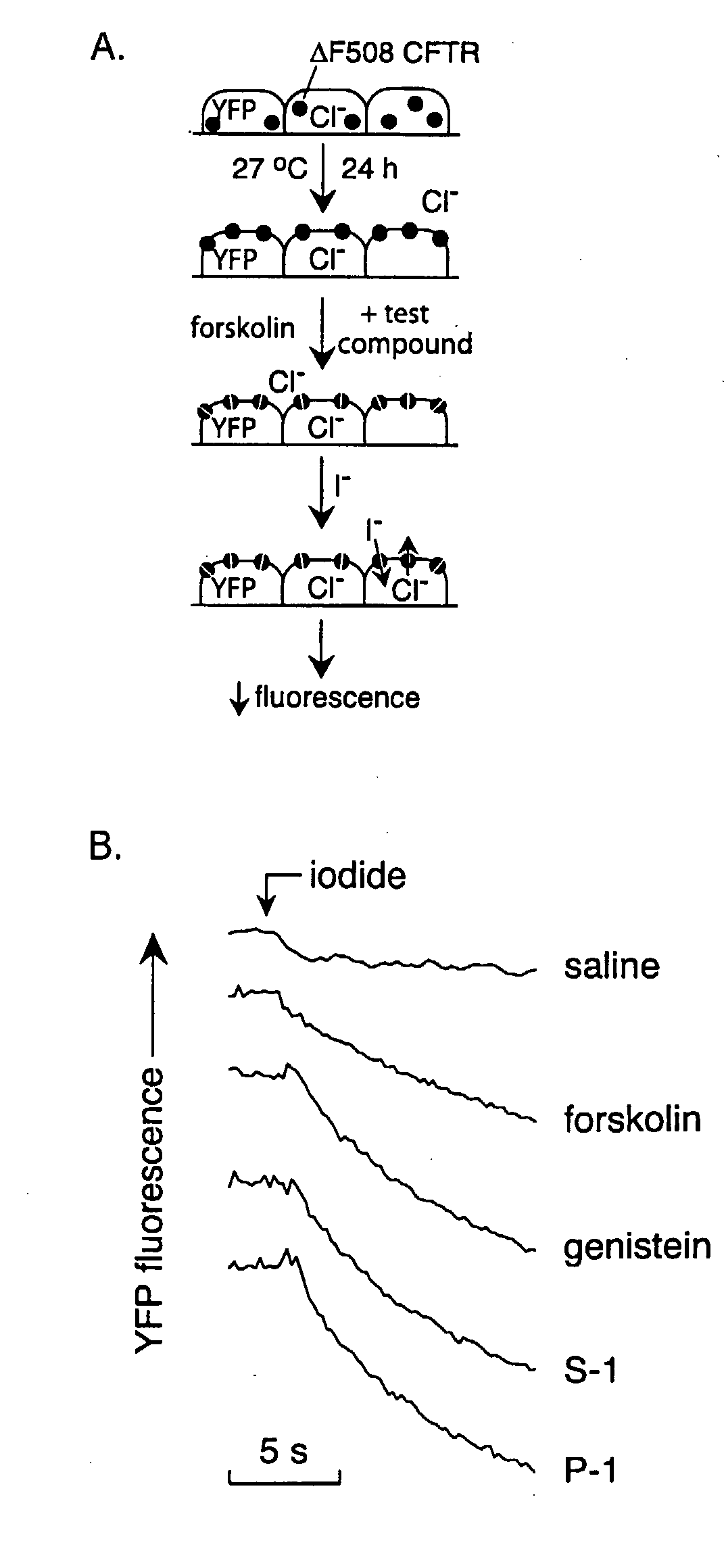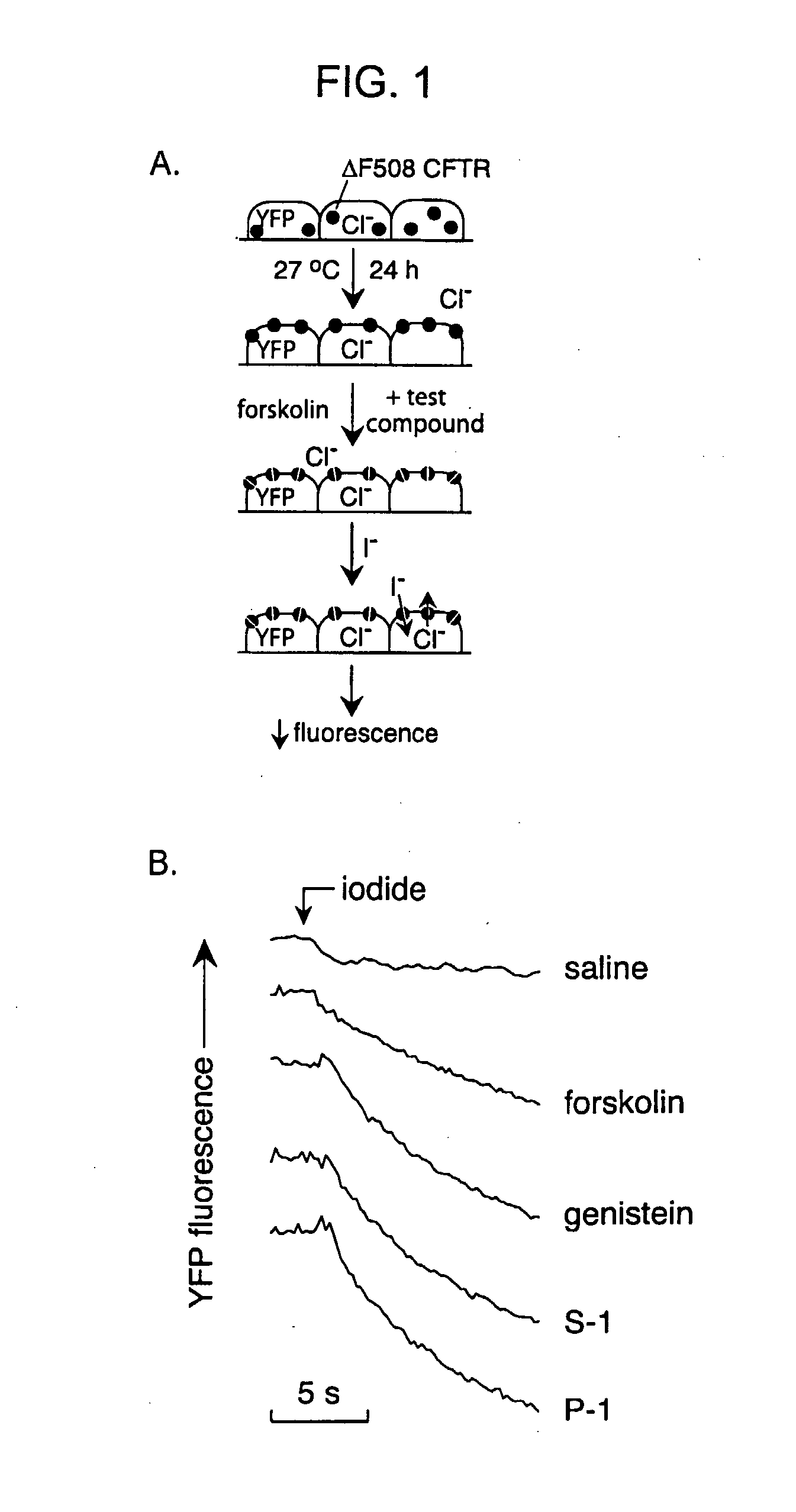Compounds Having Activity in Increasing Ion Transport by Mutant-Cftr and Uses Thereof
a technology of ion transport and compounds, which is applied in the field of compounds having activity in increasing ion transport by mutantcftr, can solve the problems of not offering clinically useful therapies, and progressing deterioration of lung function, and achieves the effect of increasing activity
- Summary
- Abstract
- Description
- Claims
- Application Information
AI Technical Summary
Benefits of technology
Problems solved by technology
Method used
Image
Examples
example 1
Screening Assays and Structure-Activity Relationship
[0188]The high-throughput screen was designed to identify compounds that activated ΔF508-CFTR when expressed at the cell plasma membrane. FRT epithelial cells co-expressing ΔF508-CFTR and a high sensitivity yellow fluorescent protein-based halide indicator were incubated at 27° C. for 24 h to permit ΔF508-CFTR plasma membrane targeting (FIG. 1, panel A). After washing, forskolin (20 μM) and test compounds (2.5 μM) were added to individual wells of 96-well plates. The I− influx assay was carried out ˜15 min later by measurement of the time course of decreasing YFP fluorescence after creation of an inwardly-directed I− gradient. A high concentration of forskolin was used to identify ΔF508-CFTR potentiators that may interact directly with ΔF508-CFTR rather than alter cAMP concentration. Since activation of CFTR requires cAMP stimulation, forskolin, an enhancer of cAMP, was added to the in vitro models in order to mimic the cellular cA...
example 2
Short-Circuit Current Analysis
[0192]Short-circuit current analysis was done on each of these compounds to confirm bona fide activation of ΔF508-CFTR Cl− currents. Experiments were done after basolateral membrane permeabilization and in the presence of a transepithelial Cl− gradient, so that short-circuit current represents apical membrane Cl− current. Representative data are shown in FIG. 4, panel A. CFTR-mediated chloride currents measured in FRT cells expressing ΔF508-CFTR. Cells were plated on a permeable support to generate a polarized epithelium, cultured for 5-7 days, and then incubated at 27° C. for 24 hours. Transepithelial chloride current was measured in a modified Ussing chamber in the presence of a chloride gradient. Cells were maximally stimulated with forskolin (20 μM) and then with the indicated concentrations of the phenylglycine containing compound P-1 and the sulfonamide containing compound S-1. Specific activation of CFTR is demonstrated by the block of current ca...
example 3
cAMP Analysis
[0194]An analysis of compound specificity was also performed. Cells were incubated with potentiators in the presence of a low concentration of forskolin (0.5 μM), lysed, and assayed for cAMP. The results show that the compounds P-1 and S-1 did not increase cAMP above the level induced by forskolin 0.5 ZM alone (FIG. 6, panel A), whereas the compound CFTRact-16, an indirect activator of CFTR (Ma et al., J. Biol. Chem. 277:37235-37241 (2002)), strongly increased cAMP. In addition, multiple drug resistance protein-1 (MDR-1) activity was assayed by intracellular accumulation of the fluorescent probe rhodamine 123. The wo cell lines used in the assay were the parental human tracheal cell line 9HTEo-, and its multidrug resistant subclone 9HTEo- / Dx that strongly expresses MDR-1 (Rasola et al., J. Biol. Chem. 269:1432-1436 (1994)). The results show that the 9HTEo- / Dx cells accumulate much less rhodamine 123 than 9HTEo-cells as a consequence of MDR-1 mediated dye extrusion. Dye ...
PUM
| Property | Measurement | Unit |
|---|---|---|
| Molar density | aaaaa | aaaaa |
| Molar density | aaaaa | aaaaa |
| Molar density | aaaaa | aaaaa |
Abstract
Description
Claims
Application Information
 Login to View More
Login to View More - R&D
- Intellectual Property
- Life Sciences
- Materials
- Tech Scout
- Unparalleled Data Quality
- Higher Quality Content
- 60% Fewer Hallucinations
Browse by: Latest US Patents, China's latest patents, Technical Efficacy Thesaurus, Application Domain, Technology Topic, Popular Technical Reports.
© 2025 PatSnap. All rights reserved.Legal|Privacy policy|Modern Slavery Act Transparency Statement|Sitemap|About US| Contact US: help@patsnap.com



